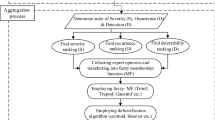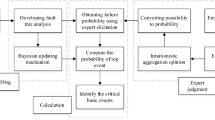Abstract
Maintenance errors in automobiles can lead to premature failures or even accidents. This is attributed to system design, contextual factors prevailing at the garages and human elements performing the maintenance tasks. Use of two well known diagrammatic procedures; event tree diagram and Fishbone diagram, are applied to understand failure initiation of maintenance errors and its effects, and identifying causes and sub-causes attributed to these respectively. This is followed by use of soft computing technique of fuzzy cognitive map to model the interrelationship among maintenance error causes and asses the failure due to these. This is demonstrated through a case study. The proposed methodology helps in better understanding of maintenance errors and the failures attributed to these. Moreover, it is capable of handling high degree of uncertainty and variability associated with the maintenance errors. It provides a ranking of maintenance errors, which can guide automobile service organizations in providing quality and reliability of service, including feedback to designers and practicing engineers in minimizing maintenance errors.






Similar content being viewed by others
References
Aalipour M, Ayele YZ, Barabadi A (2016) Human reliability assessment (HRA) in maintenance of production process: a case study. Int J Syst Assur Eng Manag 7(2):229–238
Aldemir T (2013) A survey of dynamic methodologies for probabilistic safety assessment of nuclear power plants. Ann Nucl Energy 52:113–124
Alileche N, Olivier D, Estel L, Cozzani V (2016) Analysis of domino effect in process industry using the event tree method. Saf Sci. doi:10.1016/j.ssci.2015.12.028
Augustine M, Yadav OP, Jain R, Rathore A (2012) Cognitive map-based system modeling for identifying interaction failure modes. Res Eng Des 23(2):105–124
Axelrod R (1976) Structure of decision: the cognitive maps of political elites, 1st edn. Princeton University Press, New Jersey
Berger A (1997) Continuous improvement and kaizen: standardization and organizational designs. Int Manuf Syst 8(2):110–117
Borsci S, Lawson G, Broome S (2015) Empirical evidence, evaluation criteria and challenges for the effectiveness of virtual and mixed reality tools for training operators of car service maintenance. Comput Ind 67:17–26
Brown M, Proschan F (1983) Imperfect repair. J Appl Probab 20(4):851–859
Chiu MC, Hsieh MC (2016) Latent human error analysis and efficient improvement strategies by fuzzy TOPSIS in aviation maintenance tasks. Appl Ergon 54:136–147
Civil Aviation Authority (1992) Flight safety occurrence digest. Techical Report No. 92/D/12. London, UK
Civil Aviation Authority (2009) Aircraft Maintenance Incident Analysis. CAA Paper 05, West Sussex, UK
Coulibaly A, Houssin R, Mutel B (2008) Maintainability and safety indicators at design stage for mechanical products. Comput Ind 59(5):438–449
Crocker J (1999) Effectiveness of maintenance. J Qual Maint Eng 5(4):307–313
Dekker R (1996) Applications of maintenance optimization: a review and analysis. Reliab Eng Syst Saf 51(3):229–240
Desa MI, Christer AH (2001) Modelling in the absence of data: a case study of fleet maintenance in developing country. J Oper Res Soc 52(3):247–260
Dhillon BS (2014) Human error in maintenance: an investigative study for the factories of the future. In: 27th international conference on CAD/CAM, robotics and factories of the future. Middlesex, London, 22–24 July, pp 1–13
Dhillon BS, Liu Y (2006) Human error in maintenance: a review. J Qual Maint Eng 12(1):21–36
Dhillon BS, Singh C (1981) Engineering reliability: new techniques and applications. Wiley, New York
Di Fazio AR, Duraccio V, Varilone P, Verdea P (2014) Voltage sags in the automotive industry: analysis and solutions. Electr Power Syst Res 110:25–30
Drury CG (1996) Automation in quality control and maintenance. In: Parasuraman R, Mouloua M (eds) Automation and human performance: theory and applications. Lawrence Erlbaum Associates, Mahwah, pp 407–426
European Industrial Gases Association AISBL (2009) Safety information human factors. Avenue Des Arts, Brussels
Flage R (2014) A delay time model with imperfect and failure-inducing inspections. Reliab Eng Syst Saf 124:1–12
Foord AG, Gulland WG (2006) Can technology eliminate human errors? Trans I Chem E Part B 84(B3):171–173
Garg H (2014) Reliability, availability and maintainability analysis of industrial systems using PSO and fuzzy methodology. MAPAN J Metrol Soc I 29(2):115–129
Garg H (2016) Bi-criteria optimization for finding the optimal replacement interval for maintaining the performance of the process industries. In: Vasant P, Weber GW, Dieu VN (eds) Modern optimization algorithms and application in engineering and economics, chapter 25. IGI Global, Hershey, pp 643–675
Garg H, Sharma SP (2012) A two-phase approach for reliability and maintainability analysis of an industrial system. Int J Reliab Qual Saf Eng 19(3):1250013
Garg H, Rani M, Sharma SP (2013) Preventive maintenance scheduling of the pulping unit in a paper plant. Jpn J Ind Appl Math 30(2):397–414
Gupta P, Gandhi OP (2014) Equipment redesign feasibility through maintenance-work-order records using fuzzy cognitive maps. Int J Syst Assur Eng Manag 5(1):21–31
Hameed A, Khan F, Ahmed S (2016) A risk-based shutdown inspection and maintenance interval estimation considering human error. Process Saf Environ 100:9–21
Health and Safety Executive (2016) Human factors: maintenance error. http://www.hse.gov.uk/humanfactors/topics/error.htm. Accessed 16 Apr 2016
Heyes AM (1998) Automotive component failures. Eng Fail Anal 4(1):129–141
Hobbs A, Kanki BG (2008) Patterns of error in confidential maintenance incident reports. Int J Aviat Psychol 18(1):5–16
Hobbs A, Williamson A (2003) Association between errors and contributing factors in aircraft maintenance. Hum Factors 45(2):186–201
Hockley C, Philips P (2012) The impact of no fault found on through-life engineering services. J Qual Maint Eng 18(2):141–153
Hollnagel E (2002) Understanding accidents—from root causes to performance variability. In: Proceedings of the IEEE 7th conference on human factors and power plants, 2002. Scottsdale, Arizona, 15–19 September, pp 1–6
Hong ES, Lee IM, Shin HS, Nam SW, Kong JS (2009) Quantitative risk evaluation based on event tree analysis technique: application to the design of shield TBM. Tunn Undergr Space Technol 24(3):269–277
Ishikawa K (1982) Guide to quality control, 2nd rev edn. Asian Productivity Organization, Tokyo
Jackson C, Mailler B (2013) Post-servicing failure rates: optimizing preventive maintenance interval and quantifying maintenance induced failure in repairable Systems. In: Proceedings of IEEE annual reliability and maintainability symposium (RAMS), Orlando, Florida, USA, 28–31 January, pp 1–7
Kang I, Lee S, Choi J (2006) Using fuzzy cognitive map for the relationship management in airline service. Expert Syst Appl 26(4):545–555
Kang B, Mo H, Sardiq R, Deng Y (2016) Generalized fuzzy cognitive maps: a new extension of fuzzy cognitive maps. Int J Syst Assur Eng Manag 7(2):156–166
Khan S, Philips P, Hockley C, Jennions I (2014) No fault found events in maintenance engineering part 2: root causes, technical developments and future research. Reliab Eng Syst Saf 123:196–208
Kletz TA (1995) Equipment maintenance. In: Grossell SS, Crow DA (eds) Handbook of highly toxic materials handling and management. Marcel Dekker, New York, pp 439–469
Kontogiannis T (1997) A framework for the analysis of cognitive reliability in complex systems: a recovery centered approach. Reliab Eng Syst Saf 58(3):233–250
Kosko B (1986) Fuzzy cognitive maps. Int J Man Mach Stud 24(1):65–75
Kumar VNA, Gandhi OP (2011) Quantification of human error in maintenance using graph theory and matrix approach. Qual Reliab Eng Int 27(8):1145–1172
Kumar R, Barabady J, Markeset T, Kumar U (2012) Improving maintainability in extreme cold climatic conditions. Int J Perform Eng 8(5):563–572
Kumar VNA, Gandhi MS, Gandhi OP (2013) Identification and assessment of factors influencing human reliability in maintenance. Qual Reliab Eng Int 31(2):169–181
Lattanzio D, Patankar K, Kanki BG (2008) Procedural error in maintenance: a review of research and methods. Int J Aviat Psychol 18(1):17–29
Lees FP (2012) Loss prevention in the process industries. Butterworth-Heinemann, London, pp 1–4
Liang JS (2014) The service task implementation in automotive troubleshooting using an ontology-based knowledge support system. Proc Inst Mech Eng Part D J Automob Eng 228(13):1599–1621
Lin TR, Tan ACC, Howard I, Pan J, Crosby P, Mathew J (2011) Development of a diagnostic tool for condition monitoring of rotating machinery. In: Proceedings of ICOMS asset management conference, Queensland 16–20 May 2011, pp 1–9
Mansell N (1995) Nigel Mansell—my autobiography. Harper Collin, London
MIL-HDBK-472 (1966) Maintainability prediction. Military standardization handbook. US Department of Defence, Washington
Moreno VC, Papasidero S, Emrys G, Scarponi Guglielmi D, Cozzani V (2015) Analysis of accidents in biogas production and upgrading. Renew Energy. doi:10.1016/j.renene.2015.10.017
Murugan R, Ramasamy R (2015) Failure analysis of power transformer for effective maintenance planning in electric utilities. Eng Fail Anal 55:182–192
Nakagawa T, Yasui K (1987) Optimum policies for a system with imperfect maintenance. IEEE Trans Reliab 36(5):631–633
Okoh P, Haugen S (2013a) The influence of maintenance on some selected major accidents. Chem Eng Trans 31:493–498
Okoh P, Haugen S (2013b) Maintenance-related major accidents: classification of causes and case study. J Loss Prev Process Ind 26(6):1060–1070
Pannell DJ (1997) Sensitivity analysis of normative economic models: theoretical framework and practical strategies. Agric Econ 16(2):139–152
Papageorgiou EI (2011) Review study on fuzzy cognitive maps and their applications during the last decade. In: IEEE international conference on fuzzy systems, Taipei, Taiwan, 27–30 June, pp 828–835
Peláez CE, Bowles JB (1995) Using fuzzy cognitive maps as a system model for failure modes and effects analysis. Inf Sci 88(1–4):177–199
Pennie D, Brook-Carter N, Gibson W (2007) Human factors guidance for maintenance. In: Human factors in ship design, safety and operation conference. The Royal Institution of Naval Architects, London
Pham H, Wang H (1996) Imperfect maintenance. Eur J Oper Res 94(3):425–438
Rankin B (1996) Boeing introduces MEDA, maintenance error decision aid. Maintenance Human Factors Group, Maintenance & Ground Operations Systems, Boeing Commercial Airplane Group
Rankin W, Hibit R, Allen J, Sargent E (2000) Development and evaluation of the maintenance error decision aid (MEDA) process. Int J Ind Ergon 26(2):261–276
Rao RV, Davim JP (2008) A decision-making framework model for material selection using a combined multiple attribute decision-making method. Int J Adv Manuf Technol 35(7):751–760
Rashid HSJ, Place CS, Braithwaite GR (2014) Eradicating root causes of aviation maintenance errors: introducing the AMMP. Cogn Technol Work 16(1):71–90
Rasmussen J (1982) Human errors: a taxonomy for describing human malfunctions in industrial fittings. J Occup Accid 4(2–4):311–333
Rasmussen J (1983) Skills, rules and knowledge: signals, signs and symbols, and other distinctions in human performance models. IEEE Trans Syst Man Cybern 13(3):257–266
Reason J, Hobbs A (2003) Managing maintenance error: a practical guide. Ashgate Publishing Company, Burlington
Saltelli A (2002) Sensitivity analysis for importance assessment. Risk Anal 22(3):1–12
Singh S, Kumar R, Kumar U (2015) Modelling factors affecting human operator failure probability in railway maintenance tasks: an ISM-based analysis. Int J Syst Assur Eng Manag 6(2):129–138
Stephens RI, Fatemi A, Stephens RR, Fuchs HO (2001) Metal fatigue in engineering. Wiley, Danver
Stylios CD, Groumpos PP (1999) Mathematical formulation of fuzzy cognitive maps. In: Proceedings of the 7th Mediterranean conference on control and automation (MED99). Haifa, Israel, 28–30 June, pp 2251–2261
Taber R (1991) Knowledge processing with fuzzy cognitive maps. Expert Syst Appl 2(1):83–87
Taylor JC (2000) The evolution and effectiveness of maintenance resource management (MRM). Int J Ind Ergon 26(2):201–215
The Savvy Aviator #53: The dark side of maintenance. http://www.avweb.com/news/savvyaviator/savvy_aviator_53_dark_side_of_maintenance_196909-1.html. Accessed 28 Mar 2016
Wu TM, Hwang SL (1989) Maintenance error reduction strategies in nuclear power plants, using root cause analysis. Appl Ergon 20(2):115–121
Zhou S, Liu ZQ, Zhang JY (2006) Fuzzy causal networks: general model, inference and convergence. IEEE Trans Fuzzy Syst 14(3):412–420
Author information
Authors and Affiliations
Corresponding author
Rights and permissions
About this article
Cite this article
James, A.T., Gandhi, O.P. & Deshmukh, S.G. Assessment of failures in automobiles due to maintenance errors. Int J Syst Assur Eng Manag 8, 719–739 (2017). https://doi.org/10.1007/s13198-017-0589-5
Received:
Revised:
Published:
Issue Date:
DOI: https://doi.org/10.1007/s13198-017-0589-5




